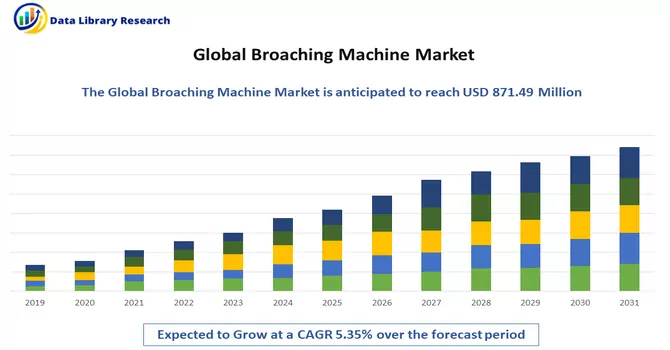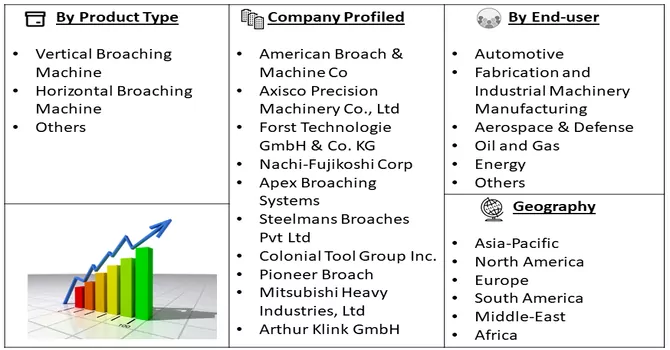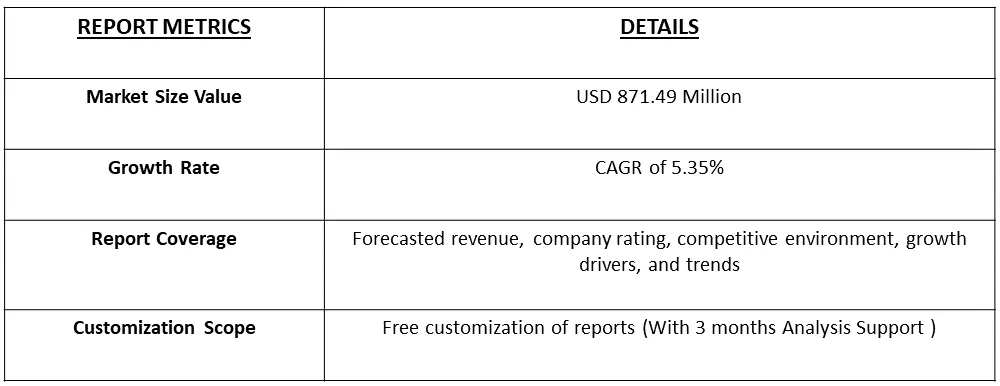The Global Broaching Machines Market is currently valued at USD 871.49 Million in 2023 and Is Expected To Reach a CAGR of 5.35%.

Get Complete Analysis Of The Report - Download Free Sample PDF
The Broaching Machine market is a crucial segment within the machinery industry, playing a pivotal role in precision metalworking operations. Broaching machines are utilized for the efficient and precise cutting of intricate shapes and forms in workpieces, making them indispensable in industries such as automotive, aerospace, and manufacturing. These machines offer advantages in terms of accuracy, speed, and versatility, making them preferred for applications requiring high precision and productivity. With the continual advancements in technology, the Broaching Machine market is witnessing innovations that enhance automation, tooling capabilities, and overall efficiency, addressing the evolving needs of modern manufacturing processes.
As industries strive for increased productivity and quality, the Broaching Machine market remains a cornerstone in achieving these objectives through its contributions to the precision machining sector.The primary growth driving factor for the Broaching Machine market lies in its indispensable role in precision machining, particularly in the automotive and aerospace industries. As manufacturing demands for intricate and accurate metal components increase, the need for efficient and precise cutting processes becomes paramount. Broaching machines address this demand by offering unparalleled accuracy, speed, and versatility in shaping workpieces. Moreover, ongoing technological advancements, such as improved automation and enhanced tooling capabilities, contribute to the market's growth by making these machines more efficient and adaptable to evolving manufacturing requirements. The continuous pursuit of enhanced productivity and quality in metalworking processes ensures a sustained demand for Broaching Machines in diverse industrial applications.
Market Segmentation: Global Broaching Machine Manufacturers and the Market is Segmented by Product Type (Vertical Broaching Machine, Horizontal Broaching Machine, and Others), by End-use (Automotive, Fabrication, and Industrial Machinery Manufacturing, Aerospace & Defense, Oil and Gas, and Energy, and Others) and Geography (North America, Europe, Asia-Pacific, the Middle East and Africa, and Latin America). The market provides the value (in USD million) for the above-mentioned segments.

For Detailed Market Segmentation - Download Free Sample PDF
In the evolving landscape of the Broaching Machine market, several trends are shaping the industry's trajectory. One notable trend is the increasing integration of advanced technologies, such as computer numerical control (CNC) systems and automation, into broaching machines. This integration enhances precision, flexibility, and efficiency in metalworking processes, aligning with the broader industry shift towards smart manufacturing. Additionally, there is a growing emphasis on sustainability, with manufacturers exploring eco-friendly materials and energy-efficient practices in broaching machine design and production. Furthermore, the trend towards customization and versatility in machining solutions is driving innovations, allowing broaching machines to handle a diverse range of workpieces and geometries. As industries continue to demand higher efficiency, accuracy, and sustainability, these trends are likely to shape the future trajectory of the Broaching Machine market.
Market Drivers:
Technological advancements
Technological advancements have become a driving force across industries, revolutionizing the way we live and work. In the realm of manufacturing, innovations such as artificial intelligence, robotics, and the Internet of Things (IoT) are transforming traditional processes. These advancements enhance efficiency, accuracy, and automation, leading to increased productivity and cost-effectiveness. In healthcare, breakthroughs in medical technologies are improving diagnostics and treatment options. The field of information technology sees constant evolution with developments in cloud computing, cybersecurity, and data analytics. Moreover, in transportation, the emergence of electric and autonomous vehicles represents a paradigm shift. As technology continues to progress, its pervasive influence underscores its role as a catalyst for societal and economic transformation, shaping the future landscape of various sectors.
The increasing demand for precision manufacturing
The increasing demand for precision manufacturing is a defining trend in today's industrial landscape. Industries such as aerospace, automotive, healthcare, and electronics are placing a heightened emphasis on producing components with exceptionally tight tolerances and intricate specifications. Precision manufacturing involves advanced techniques and technologies that ensure accuracy and consistency in the fabrication of parts and products. This demand is driven by the need for high-quality, reliable components in critical applications. Precision-manufactured parts not only enhance the overall performance and efficiency of end products but also contribute to advancements in technology, innovation, and the overall competitiveness of industries. As the pursuit of perfection in manufacturing intensifies, the market continues to witness a growing reliance on precision machining processes to meet the exacting standards of modern industrial applications.
Market Restraints:
Market restraints for the Broaching Machine market stem from several factors. The high initial capital investment required for purchasing and setting up advanced broaching machines presents a significant financial hurdle for potential buyers, particularly small and medium-sized enterprises (SMEs). Additionally, broaching machines, while highly effective for specific applications, may have limited versatility, posing challenges in addressing diverse machining needs. This limitation could lead industries with varied and complex machining requirements to explore alternative solutions. Moreover, the operation of broaching machines demands skilled personnel, and the shortage of trained operators can result in increased operational costs and potential downtimes. These factors collectively contribute to obstacles in the widespread adoption of broaching machines across industries, highlighting the need for strategic measures to mitigate these challenges and enhance market accessibility.
The Broaching Machine market, like many industries, experienced the impact of the COVID-19 pandemic. The global disruptions caused by lockdowns, supply chain disruptions, and reduced industrial activities significantly affected the demand for manufacturing equipment, including broaching machines. Many manufacturing facilities faced temporary closures, leading to delayed or cancelled projects and a decrease in capital expenditure. The uncertainty surrounding the pandemic also influenced decision-making processes, with companies prioritizing essential operations and cost-cutting measures. However, as the industrial sector gradually rebounds and adapts to the new normal, there is an opportunity for the Broaching Machine market to recover. The ongoing emphasis on automation and precision manufacturing, driven by the need for efficiency and quality, could contribute to the resurgence of demand for broaching machines in various industries. Additionally, as global supply chains stabilize, the market is expected to witness a gradual recovery, with manufacturers reassessing their machining capabilities and investing in advanced technologies for improved resilience in the post-pandemic era.
Segmental Analysis:
Vertical Broaching Machine Segment is Expected to Witness Significant Growth Over the Forecast Period
Vertical broaching machines offer several advantages in precision machining operations. Their vertical orientation allows for a compact footprint, making them suitable for space-constrained manufacturing environments. These machines provide exceptional accuracy and repeatability in cutting internal keyways, splines, or other intricate shapes. The vertical design also facilitates easy chip evacuation, reducing the risk of tool jamming and enhancing overall efficiency. Vertical broaching machines are known for their versatility, accommodating a range of workpiece sizes and materials. Additionally, their rigidity and stability contribute to extended tool life and consistent performance. The vertical orientation enables gravity to assist in tool descent, resulting in smoother operations and reduced wear on cutting tools. Overall, the advantages of vertical broaching machines make them a preferred choice for industries requiring precise and efficient internal machining processes.
Automotive Segment is Expected to Witness Significant Growth Over the Forecast Period
The Automotive and Broaching System Market showcases a symbiotic relationship as automotive manufacturing increasingly adopts advanced machining processes. Broaching systems play a crucial role in the production of intricate automotive components, offering precision and efficiency in shaping keyways, gears, and other essential features. As the automotive industry evolves towards lightweight, enhanced fuel efficiency, and innovative designs, the demand for specialized broaching systems grows. These systems contribute to the manufacturing of critical parts such as engine components, transmission gears, and steering system elements with high accuracy and consistency. The integration of broaching systems into modern automotive production lines enhances overall productivity and cost-effectiveness. The market reflects a trajectory where advancements in broaching technologies align seamlessly with the evolving demands of the automotive sector, emphasizing efficiency, precision, and adaptability in the production of complex components essential for the contemporary automotive landscape.
North America Region is Expected to Witness Significant Growth over The Forecast Period
In North America, the Broaching System Market is witnessing dynamic growth, driven by the region's robust manufacturing sector, particularly in the automotive and aerospace industries. The adoption of advanced machining processes, including broaching systems, is instrumental in achieving precision and efficiency in the production of critical components. As North American industries emphasize technological advancements and automation in their manufacturing practices, the demand for high-performance broaching systems has surged. These systems cater to the intricate machining requirements of various sectors, contributing to the production of key components like gears, splines, and bushings. The market is characterized by a focus on innovation, with manufacturers introducing advanced broaching technologies that enhance productivity and reduce production costs. North America's position as a key player in the global manufacturing landscape underscores its significant role in shaping the trajectory of the Broaching System Market, where the convergence of technological sophistication and industrial demands continues to drive market expansion and innovation.

Get Complete Analysis Of The Report - Download Free Sample PDF
The analyzed market exhibits a high degree of fragmentation, primarily attributable to the presence of numerous players operating on both a global and regional scale. The competitive landscape is characterized by a diverse array of companies, each contributing to the overall market dynamics. This fragmentation arises from the existence of specialized solution providers, established industry players, and emerging entrants, all vying for market share. The diversity in market participants is underscored by the adoption of various strategies aimed at expanding the company presence. On a global scale, companies within the studied market are strategically positioning themselves through aggressive expansion initiatives. This often involves entering new geographical regions, targeting untapped markets, and establishing a robust global footprint. The pursuit of global expansion is driven by the recognition of diverse market opportunities and the desire to capitalize on emerging trends and demands across different regions. Simultaneously, at the regional level, companies are tailoring their approaches to align with local market dynamics. Regional players are leveraging their understanding of specific market nuances, regulatory environments, and consumer preferences to gain a competitive edge. This regional focus allows companies to cater to the unique needs of local clientele, fostering stronger market penetration. To navigate the complexities of the fragmented market, companies are implementing a range of strategies. These strategies include investments in research and development to stay at the forefront of technological advancements, mergers and acquisitions to consolidate market share, strategic partnerships for synergies, and innovation to differentiate products and services. The adoption of such multifaceted strategies reflects the competitive nature of the market, with participants continually seeking avenues for growth and sustainability. In essence, the high fragmentation in the studied market not only signifies the diversity of players but also underscores the dynamism and competitiveness that drive ongoing strategic manoeuvres. As companies explore various avenues for expansion, the market continues to evolve, presenting both challenges and opportunities for industry stakeholders.
Recent Development:
1) In 2020, While modern broaching has its roots in the 19th century, recent advancements have propelled this over 150-year-old technology into the new millennium, particularly with the integration of broaching into contemporary CNC machining environments. The technology, historically straightforward, has now evolved to offer tool systems that enable both linear and rotary broaching processes, allowing for the machining of parts in a single setup rather than as a secondary operation. This innovation not only enhances efficiency but also significantly reduces costs compared to traditional methods. Broaching part features on a CNC machine has become a cost-effective solution, making it increasingly popular in modern manufacturing. The ability to seamlessly integrate broaching into CNC machining processes aligns with the demand for streamlined operations and cost-efficient manufacturing, thereby contributing to the growth and evolution of the broaching market.
Q1. What was the Broaching Machine Market size in 2023?
As per Data Library Research the Global Broaching Machines Market is currently valued at USD 871.49 Million in 2023.
Q2. At what CAGR is the Broaching Machine market projected to grow within the forecast period?
Broaching Machine Market is Expected To Reach a CAGR of 5.35% over the forecast period.
Q3. What are the factors driving the Broaching Machine Market?
Key factors that are driving the growth include the Technological advancements and The increasing demand for precision manufacturing.
Q4. Which Region is expected to hold the highest Market share?
North America region is expected to hold the highest Market share.
Data Library Research are conducted by industry experts who offer insight on industry structure, market segmentations technology assessment and competitive landscape (CL), and penetration, as well as on emerging trends. Their analysis is based on primary interviews (~ 80%) and secondary research (~ 20%) as well as years of professional expertise in their respective industries. Adding to this, by analysing historical trends and current market positions, our analysts predict where the market will be headed for the next five years. Furthermore, the varying trends of segment & categories geographically presented are also studied and the estimated based on the primary & secondary research.
In this particular report from the supply side Data Library Research has conducted primary surveys (interviews) with the key level executives (VP, CEO’s, Marketing Director, Business Development Manager and SOFT) of the companies that active & prominent as well as the midsized organization
FIGURE 1: DLR RESEARH PROCESS

Extensive primary research was conducted to gain a deeper insight of the market and industry performance. The analysis is based on both primary and secondary research as well as years of professional expertise in the respective industries.
In addition to analysing current and historical trends, our analysts predict where the market is headed over the next five years.
It varies by segment for these categories geographically presented in the list of market tables. Speaking about this particular report we have conducted primary surveys (interviews) with the key level executives (VP, CEO’s, Marketing Director, Business Development Manager and many more) of the major players active in the market.
Secondary ResearchSecondary research was mainly used to collect and identify information useful for the extensive, technical, market-oriented, and Friend’s study of the Global Extra Neutral Alcohol. It was also used to obtain key information about major players, market classification and segmentation according to the industry trends, geographical markets, and developments related to the market and technology perspectives. For this study, analysts have gathered information from various credible sources, such as annual reports, sec filings, journals, white papers, SOFT presentations, and company web sites.
Market Size EstimationBoth, top-down and bottom-up approaches were used to estimate and validate the size of the Global market and to estimate the size of various other dependent submarkets in the overall Extra Neutral Alcohol. The key players in the market were identified through secondary research and their market contributions in the respective geographies were determined through primary and secondary research.
Forecast Model
